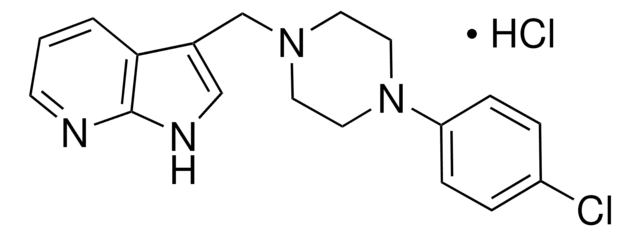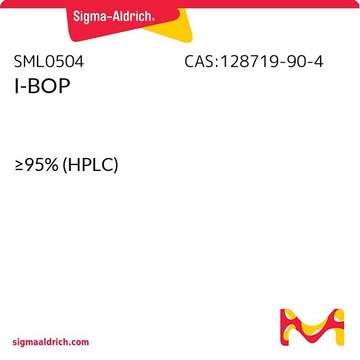S2816
SKF-83959 hydrobromide
≥98% (HPLC), solid
Synonym(s):
6-Chloro-7,8-dihydroxy-3-methyl-1-(3-methylphenyl)-2,3,4,5-tetrahydro-1H-3-benzazepine hydrobromide
Sign Into View Organizational & Contract Pricing
All Photos(1)
About This Item
Empirical Formula (Hill Notation):
C18H20NClO2 · HBr
CAS Number:
Molecular Weight:
398.72
MDL number:
UNSPSC Code:
12352200
PubChem Substance ID:
NACRES:
NA.77
Recommended Products
Quality Level
Assay
≥98% (HPLC)
form
solid
color
white
solubility
DMSO: >20 mg/mL
H2O: insoluble
SMILES string
Br[H].CN1CCc2c(Cl)c(O)c(O)cc2C(C1)c3cccc(C)c3
InChI
1S/C18H20ClNO2.BrH/c1-11-4-3-5-12(8-11)15-10-20(2)7-6-13-14(15)9-16(21)18(22)17(13)19;/h3-5,8-9,15,21-22H,6-7,10H2,1-2H3;1H
InChI key
FHYWNBUFNGHNCP-UHFFFAOYSA-N
Gene Information
human ... DRD1(1812)
Application
SKF-83959 was used in dopamine signaling studies on eye blinking in monkeys and on phosphorylation of CaMKIIα in mice.
Biochem/physiol Actions
D1 dopamine receptor agonist. Displays antagonist activity in vitro and agonist activity in vivo.
SKF-83959 is an atypical agonist of D1 dopamine receptor and an allosteric modulator of σ-1 receptor on in brain and liver tissues. It has neuroprotective and anti-parkinsonian effects through selective activation of phosphoinositol-linked D1 receptor and promotes migration of cultures astrocytes by ERK1/2 activation. In in vitro studies SKF-83959 exhibits antagonist activity against dopamine D1 receptors coupled to adenylyl cyclase.
Storage Class Code
11 - Combustible Solids
WGK
WGK 3
Flash Point(F)
Not applicable
Flash Point(C)
Not applicable
Personal Protective Equipment
dust mask type N95 (US), Eyeshields, Gloves
Choose from one of the most recent versions:
Already Own This Product?
Find documentation for the products that you have recently purchased in the Document Library.
Katsunori Tomiyama et al.
Synapse (New York, N.Y.), 64(9), 714-720 (2010-03-27)
Orofacial movements are regulated by D(1)-like dopamine receptors interacting with additional mechanisms. Phospholipase C-related catalytically inactive protein (PRIP) regulates cell surface expression of GABA(A) receptors containing a gamma2 subunit. Mutant mice with double knockout of PRIP-1 and PRIP-2 were used
Jue Liu et al.
Neuropharmacology, 57(2), 164-171 (2009-05-26)
Recent work has demonstrated that a phosphatidylinositol (PI)-linked D(1) dopamine receptor selective agonist, SKF83959, mediates phosphatidylinositol hydrolysis via activation of phospholipase C(beta) in brain. Specific contributions of SKF83959 to synaptic plasticity have not been well elucidated. The aim of the
Hong-Yuan Chu et al.
PloS one, 5(10), doi:10-doi:10 (2010-10-20)
Although the potent anti-parkinsonian action of the atypical D₁-like receptor agonist SKF83959 has been attributed to the selective activation of phosphoinositol(PI)-linked D₁ receptor, whereas the mechanism underlying its potent neuroprotective effect is not fully understood. In the present study, the
Ling Zhang et al.
Neurochemistry international, 58(3), 281-294 (2010-12-08)
Accumulating pathological evidence showing layer-specific neuronal reduction, dendrite deficits and brain volume loss have implicated an apoptotic process in schizophrenia, but the exact mechanism remains elusive. Dopamine hyperactivity at D2 receptor sites was considered as an important mechanism in schizophrenia
Hong-Yuan Chu et al.
Journal of neuroscience research, 89(8), 1259-1266 (2011-05-04)
Dopamine (DA) profoundly modulates excitatory synaptic transmission and synaptic plasticity in the brain. In the present study the effects of SKF83959, the selective agonist of phosphatidylinositol (PI)-linked D(1) -like receptor, on the excitatory synaptic transmission were investigated in rat hippocampus.
Our team of scientists has experience in all areas of research including Life Science, Material Science, Chemical Synthesis, Chromatography, Analytical and many others.
Contact Technical Service







